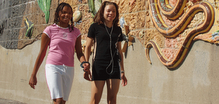Trunk or Treat!
The eyebrow-raiser of the week was our discovery of Trunk-Or-Treating. You read it right. Trunk, not Trick. According to the folks at About.com :
"Holding a Trunk-or-Treat Halloween activity is a great way to keep Halloween safe. What is a Trunk-or-Treat? It's when several families get together...park their cars in the parking lot, open up the trunks of their cars, and kids come around to each car to Trunk-or-Treat instead of going house to house to Trick-or-Treat."
So, what used to look like this:
Is starting to look like tailgating for toddlers:

Advocates for Trunk or Treating will cite the following benefits: safety from traffic, safety from crime, knowing their "neighbors", and easy walking from trunk to trunk. Interesting... Those are all the same qualities of well-designed communities.
Ironically, what many people are unable to find in their own neighborhoods, they are finding in oil-stained parking lots from coast to coast.
More than anything, the rise of Trunk-Or-Treating is a reminder of the challenges that many communities face. Fewer sidewalks, busier streets, decreased sense of community and decreased sense of safety has pushed people out of their homes and into parking lots. It's also a spooky reminder of how car-focused the average American life has become. The very idea that Trunk-Or-Treating involves kids walking around and playing on black-tar asphalt instead of a grassy park or a school football field is a tell-tale sign of our co-dependent relationship with our cars. The name "Trunk or Treat" is clever and all, but it's not enough to convince us that 3 hours in a parking lot is better than 3 hours in a park.
We need to start working to improve the places we live before empty parking lots become our safe havens, and all we're left with is junk in our trunks.
Some simple steps to take:
-Get to know your neighbors
-Start walking in your community
-Work with your city council to ensure walkability (start by learning about your existing street design standards--are pedestrian or bicycle accommodations required in your community?)
-Gather residents, city officials, and law enforcement officers to discuss and address safety concerns
-Beautify your community: organize neighborhood clean-up, pruning, and planting events













